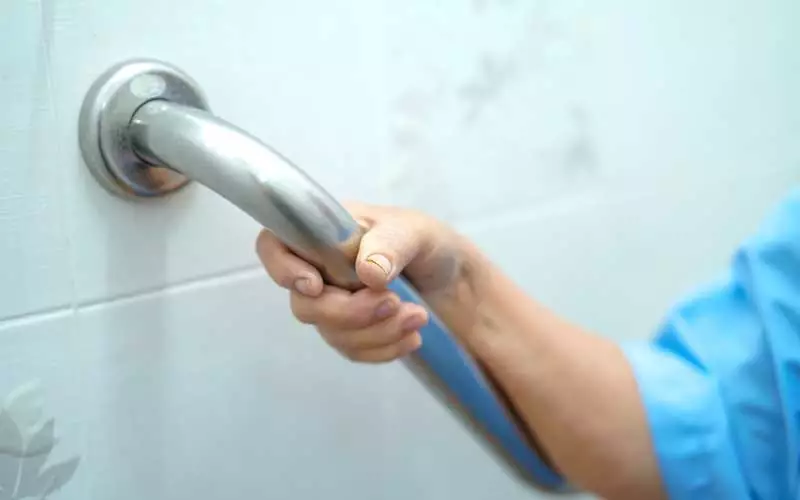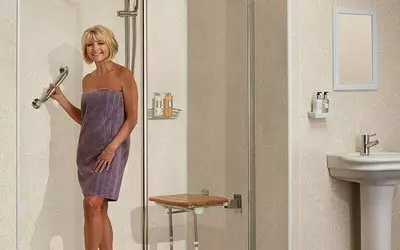
Creating an accessible bathroom isn’t just about improving quality of life. It’s about restoring independence and dignity for people with mobility challenges. However, many people delay making these essential modifications due to concerns about the cost of disabled bathroom renovations.
Our comprehensive guide breaks down all the expenses involved in creating an accessible bathroom in the UK, helping you navigate the financial aspects with confidence.
Get a FREE Brochure
Simply complete our form to see a full range of bathing solutions & their key features. It takes no time at all!
Table of contents:
-
- VAT exemptions and grants
- How much is a disability bathroom?
- Advantages of mobility bathrooms
- What to Consider When Choosing a Disability Bathroom Design
- Is a wet room more expensive than a shower room?
- How much is wet room flooring?
- Installation, labour and other costs
- Disability Bathroom Checklist
- Effects of Covid on installation
VAT exemptions and grants
The good news is that you might not need to bear the full cost of an accessible bathroom renovation.
The UK offers several financial support options that can significantly reduce your overall expenditure.
For example, if you or someone in your household has a chronic illness or disability, you may qualify for VAT relief on products designed for disability use.
This means you will pay 0% VAT instead of the standard 20% on qualifying items and installation services.
Disabled Facilities Grant (DFG)
The Disabled Facilities Grant is a local council-provided grant of up to £30,000 in England (£36,000 in Wales, £25,000 in Northern Ireland) to help with the costs of adapting your home.
If you live in Scotland, the DFG is not available, but you may be able to access other support for equipment and adaptations.
The DFG is means-tested for adults (though not for adaptations for children with disabilities) and requires an assessment by an occupational therapist.
You will need to either own the property or be a legal tenant and expect to continue living there for five years or longer.
Additional Support
Foundations is part of the Home Improvement Agencies (HIA). It helps disabled homeowners to make improvements to, repair or adapt their homes, ensuring that they can continue living in their homes safely and independently.
If you want to learn more about grants, benefits and funds that may be available to you, Turn2us and Charity Choice offer excellent advice.
Some local councils offer minor adaptation grants for smaller modifications, and some minor bathroom adaptations can be funded by NHS initiatives.
How much is a disability bathroom?
The overall cost of disabled bathroom adaptations varies depending on the type of facilities installed, the extent of structural modifications required, the quality of fixtures, and your location within the UK.
As a general guideline, basic accessibility modifications such as installing a walk-in bath or shower might start around £3,000-£5,000, while complete bathroom overhauls with premium fixtures might range from £7,000-£15,000+.
How much does a wet room cost?
You can expect to pay £5,000 to £7,000+ for a basic wet room conversion, £7,000-£10,000+ for a mid-range wet room with high-quality fixtures, and £10,000-£15,000+ for a premium wet room with extensive customisation.
Key features affecting the cost of installing a wet room include:
- Floor-to-ceiling tanking (waterproofing)
- Special drainage systems
- Non-slip flooring
- Level access shower area
- Grab rails and shower seats
- Tiling
What is the cost of a walk-in shower?
Walk-in showers offer excellent accessibility without the costs of installing a full wet room. This makes them a popular mid-range option.
Walk-in showers typically feature a low-threshold tray or level access with a partial enclosure.
For a basic walk-in shower cost, you can expect to pay in the region of £2,500 to £4,500.
For a mid-range model with additional features, you can expect to pay in the region of £4,500 to £6,500.
For a premium walk-in shower with therapeutic features, you can expect to pay over £6,500.
When choosing a walk-in shower, you may wish to consider features such as:
- Low-level or flush access trays
- Half-height doors or screens
- Thermostatic controls
- Grab rails and fold-down seating
- Slip-resistant flooring
- Adjustable shower heads
What is the cost of walk-in bath?
If you prefer bathing to showering but struggle with standard bathtubs, walk-in baths provide a safer alternative with door access and built-in seating.
A basic walk-in bath costs between £3,500 and £5,000, whereas a mid-range model with extra features costs between £5,000 to £8,000. If you want a premium bath with hydrotherapy, you can expect to pay over £8,000.
Key features that affect pricing include water-tight door mechanisms, built-in seating, quick-full and quick-drain technology, anti-scald protection, hydrotherapy jets, and slip-resistant surfaces
Advantages of mobility bathrooms
Accessible bathrooms offer numerous benefits beyond basic functionality, including:
- Enhanced safety and reduced fall risk. Fall prevention alone makes these modifications worthwhile, as bathroom falls can lead to serious injuries and hospital admissions.
- Increased independence and dignity. Being able to manage personal hygiene without assistance preserves dignity and reduces the workload for caregivers.
- Long-term cost savings. Preventing accidents and enabling ageing in place can save substantial money compared to assisted living costs.
- Improved home value. With an ageing population, accessibility features can make your property more marketable.
- Reduced strain on caregivers. Accessible bathrooms make caregiving tasks easier and safer for family members or professional carers.
- Better hygiene and health outcomes. Easier bathing leads to improved personal hygiene and better overall health.
What to consider when choosing a disability bathroom design
- User-specific needs. A person with arthritis may need different adaptations than a wheelchair user or a person with balance issues. Whenever possible, involve an occupational therapist in the planning process.
- Available space. Your existing bathroom’s dimensions will impact what’s possible. Smaller spaces may require creative solutions or possibly extending into adjacent rooms for proper wheelchair accessibility.
- Future needs. Don’t just consider current mobility needs – think about how those needs might evolve. Designing with progressive conditions in mind could prevent costly re-adaptations later down the line.
- Personal preference. Modern disability bathrooms can be stylish and harmonious with your home’s design while meeting all functional requirements.
- Water system compatibility. Your existing plumbing and water pressure may influence what fixtures are feasible without major system upgrades.
- Building Regulations. Any adaptations you make must comply with the relevant Building Regulations.
- Disruption. Consider how long you can manage without bathroom facilities during the renovation.
Is a wet room more expensive than a shower room?
Yes, wet rooms typically cost more than conventional shower rooms due to more complex installation requirements. Here’s why:
Comprehensive Waterproofing Requirements
Wet rooms require complete “tanking” (waterproofing) of the entire space, including walls and floors, creating a fully sealed environment. This process requires skilled labour and high-quality materials to ensure long-term water tightness.
Gradient Flooring Systems
Proper drainage in wet rooms relies on precisely calculated floor gradients that direct water to the drainage point. Creating these gradients often requires substantial floor modifications, especially in older properties with wooden joists.
Specialised Drainage Solutions
Wet rooms utilise either linear drains or central waste points with special shallow-profile traps, which are more expensive than standard shower trays with built-in drainage.
Additional Tiling
Without shower enclosures, wet rooms typically require more extensive tiling, increasing both material and labour costs.
Potential Structural Modifications
The weight of a properly installed wet room floor can necessitate structural reinforcement in some properties, particularly in older buildings with wooden floors.
While the cost of disabled bathroom adaptations is higher for wet rooms than standard shower rooms, the superior accessibility they provide often justifies the additional expense, particularly for wheelchair users or people with significant mobility limitations.
How much is wet room flooring?
Flooring is a key part of designing accessible wet rooms, as it must combine safety, durability, and proper drainage abilities.
The cost varies based on materials and installation requirements.
Wet room floor formers are pre-formed bases with built-in gradients. The typical cost is £200-£400 for custom sizes (up to 1200mm x 900mm) or £400-£800 for custom or larger sizes.
Tanking materials for floor waterproofing will likely cost £20-£40 per square metre for a liquid tanking membrane or £50-£90 per square metre for waterproof board systems.
You’ll need to choose suitable non-slip floor tiles. For these, you can expect to pay £20-£40 per square metre for basic porcelain anti-slip tiles or £50-£120+ for premium natural stone or designed non-slip tiles.
A standard wet room drain will likely cost in the region of £50-£150. Linear designer drains could cost up to £400, whereas pumped drainage systems could cost up to £700.
Including professional installation, you can expect to pay between £1,000 to £2,500 for a complete flooring system for a medium-sized wet room. This forms a significant part of the overall cost of disabled bathroom adaptations.
Installation, labour, and other costs
If you want to replace an existing radiator with a heated towel radiator or you want to move a radiator or towel rail to a different location, you’ll need to factor in the cost of the associated plumbing work.
If you want to install a shiny new walk-in shower, you’ll probably want to replace your toilet and sink unit at the same time. Whatever bathroom design you go for, you’ll need to factor in the cost of other elements, such as flooring, wall coverings, heating, ventilation, and lighting.
In many cases, you will need to enlist the services of a qualified electrician, heating engineer, or plasterer, which will mean incurring additional costs.
Disability bathroom checklist
Here are our top tips for planning your disability bathroom project and working out the cost of disabled bathroom.
- Measure up your bathroom and decide whether you would benefit most from a wet room, walk-in shower, or walk-in bath. Which option would be best suited to the available space?
- Decide whether you want to completely remodel the space or just install new elements, for example, replacing the bath with a walk-in bath or replacing the shower with a walk-in shower. If you’re not sure, contact our bathroom experts for advice on what’s best for you (and achievable for your property.)
- Find out whether you are entitled to VAT exemption or other financial assistance.
- Consider the finish you want to achieve and set an appropriate budget.
- If you only have one bathroom in your home, think about whether you will need to stay elsewhere during the installation. Most bathroom installations take up to two weeks, so you may wish to stay with a friend or family member while the work is being done.
Why should I choose Bathing Solutions?
Our end-to-end service includes a free home survey, where we will check your current facilities, measure your bathroom, and identify the space available. We’ll also take a look at your plumbing and electrics and what other bathroom layouts would be possible.
Following our detailed survey and discussion with you, we’ll present a range of solutions, including a free technical plan drawing to show you what your new bathroom could look like.
After that, we’ll prepare a free-of-charge, fixed-price, no-obligation quotation. Factors affecting the price include the size of your bathroom, the amount of restructuring required, the quality of materials, and luxury additions such as chromotherapy or spa-therapy baths.
If you decide to go ahead, we offer a complete supply and installation service. This includes a contract manager, who will oversee every aspect of the installation, including electrics, plumbing, flooring, and wall finishes.
Our expert team will look after everything from start to finish. All of our products and work are covered by a comprehensive guarantee. Once you’re happy, we’ll leave you to enjoy your shiny new bathroom!
(We do not offer grants or help with the process)






